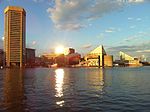National Aquarium (Baltimore)

The National Aquarium – also known as National Aquarium in Baltimore and formerly known as Baltimore Aquarium – is a non-profit public aquarium located at 501 East Pratt Street on Pier 3 in the Inner Harbor area of downtown Baltimore, Maryland in the United States. Constructed during a period of urban renewal in Baltimore, the aquarium opened on August 8, 1981. The aquarium has an annual attendance of 1.5 million visitors and is the largest tourism attraction in the State of Maryland. The aquarium holds more than 2,200,000 US gallons (8,300,000 L) of water, and has more than 17,000 specimens representing over 750 species. The National Aquarium's mission is to inspire conservation of the world's aquatic treasures. The aquarium's stated vision is to confront pressing issues facing global aquatic habitats through pioneering science, conservation, and educational programming.The National Aquarium houses several exhibits including the Upland Tropical Rain Forest, a multiple-story Atlantic Coral Reef, an open-ocean shark tank, and Australia: Wild Extremes, which won the "Best Exhibit" award from the Association of Zoos and Aquariums in 2008. The aquarium also has a "4D Immersion Theater." The aquarium opened a marine mammal pavilion on the adjacent south end of Pier 4 in 1990, and currently holds six Atlantic bottlenose dolphins. Of the six, five were born at the National Aquarium, one was born at another American aquarium. In 2003, the National Aquarium and the much older and independent National Aquarium in Washington, D.C., formed an alliance to operate as a single National Aquarium with two sites. This arrangement continued until 2013, when the Washington location closed permanently.
Excerpt from the Wikipedia article National Aquarium (Baltimore) (License: CC BY-SA 3.0, Authors, Images).National Aquarium (Baltimore)
Baltimore
Geographical coordinates (GPS) Address Nearby Places Show on map
Geographical coordinates (GPS)
| Latitude | Longitude |
|---|---|
| N 39.284398 ° | E -76.606936 ° |
Address
Marine Mammal Pavilion
500
21202 Baltimore
Maryland, United States
Open on Google Maps








